Revival of Cuban Jews in Havana: Small, but Vibrant Community
Note: Cuban Jews is part of a travel blog that we wrote during a humanitarian mission to Cuba. We are convinced that language opens a gateway to understanding culture. These pages focus on the culture of a country that has been relatively isolated for a half century. Our visit offered an opportunity to explore a place that few of our countrymen have seen. While we were there, we practiced Walkabout Language Learning to improve our Spanish and spent time with Cubans through a Jewish medical mission and informal encounters in Havana. See the list of "More Cuba Stories" on this page to explore how culture and language intertwine.
Jewish Cuba isn't on the Havana tourist circuit. Cuban Jews are not a group even hinted at in Lonely Planet Cuba or Michelin's Havana Must Sees.
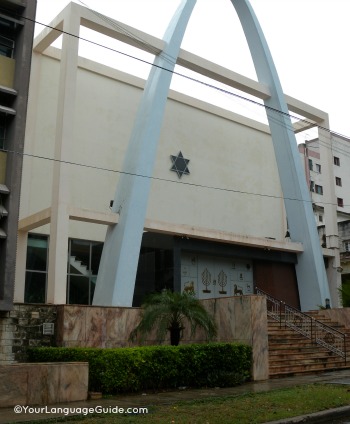 Beth Shalom, gathering place for Cuban Jews.
Beth Shalom, gathering place for Cuban Jews.Ann Marshall
No wonder: today, Jews are a tenth of what they were in 1959 -- an estimated 1,500 (of which 1,100 live in Havana), compared to 15,000 before the revolution. There's no visible Jewish part of the city, no streets of Jewish merchants. Its two cemeteries -- United Hebrew Congregation's Centro Macabeo of Cuba and the smaller Sephardic cemetery -- are tiny compared to Havana's vast (and tourist-A-list) Cementario de Cristóbal Colón.
Why the precipitous decline of Cuban Jews? No mystery here, we tell ourselves: anti-Semitism! What else?
We are a group of seven Americans in Havana to deliver medical supplies to synagogue-sponsored clinics. We are visiting all three synagogues in Havana. At each, the men and women in charge tell the same story: no, Cuba is not anti-Semitic. That's not a problem here, either historically or now. "Really?" we ask. That's hard to believe.
Castro and Cuban Jews
"It's economics, not anti-Semitism," they explain: in 1961 and 1962, Castro nationalized the country's businesses, industry, and farms. As a result, Cuba's middle class -- businessmen and professionals, which included most Cuban Jews -- fled the country.
Interestingly enough, the only business Castro left in private hands in all of Cuba was the kosher butcher shop in Havana, and though he nationalized all public religious institutions, he allowed the Albert Einstein School to continue its classes on Jewish history, Hebrew, and Yiddish.
By 1989, Cuba's Jewish population had dropped to 685. The daily minyan (a quorum of ten Jewish adults required for certain religious obligations) generally consisted of seven elderly men and three Torah scrolls, placed on chairs in a small chapel. The last rabbi had moved away. Jewish families observed Shabbat and major holidays in their own homes. The cemeteries suffered from lack of care.
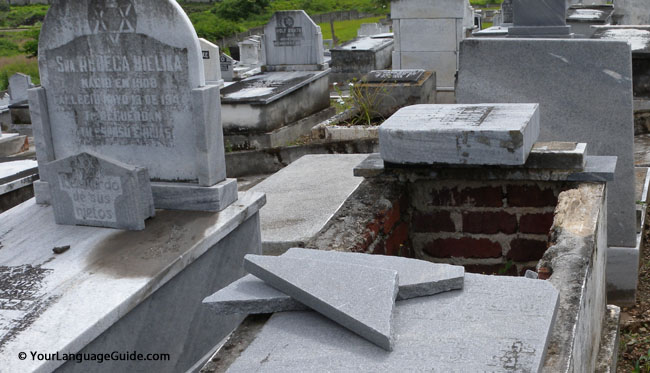 Cemeteries suffered after a decline in the Jewish population.
Cemeteries suffered after a decline in the Jewish population.Ann Marshall
Then, in 1992, Cuba revised its constitution, granting greater freedom of worship. Inside Cuba, Jews began to practice their religion more openly; aid -- both money and spiritual help -- from Jewish communities around the world began to pour in, most conspicuously from the United States.
The sign below summarizes the sentiments that we encountered in Cuba.
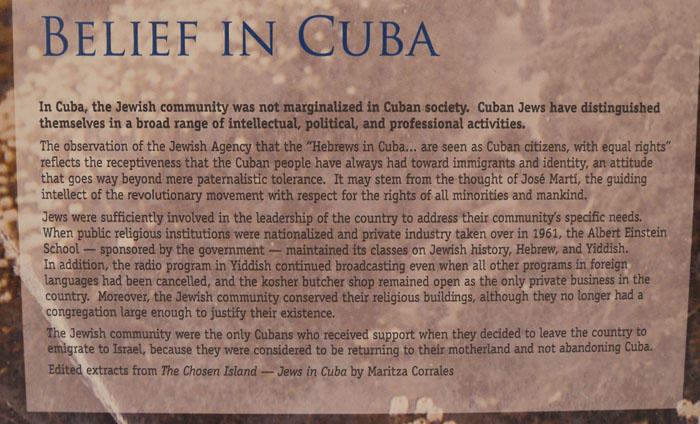
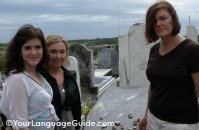 Centro Macabeo, Guanabacoa, Cuba.
Centro Macabeo, Guanabacoa, Cuba.Ann Marshall
Cuban Jews Rest In Peace
Three generations, Paula Baroff, Shaindle Schmuckler, and Raina Baroff, pay respects at the restored grave of Shaindle's aunt, Esther Farber, in the Jewish cemetery in Guanabacoa, Havana.
Jewish Cuba Today
More Cuba Stories
Today, Jewish Cuba is small, but thriving. We're seeing it first hand:
- Early in the day, we tour the Museo de la Revolución, housed in the former Palacio Presidencial (the Cuban equivalent of our White House). Its elegant interior was designed by Tiffany's of New York, and the Michelin guide says, "If you visit only one history museum in Havana, this should be your choice." It's intriguing to be sure, mostly photos and newspaper clippings of the revolutionary years, plus a few physical mementos . . . studded with a wealth of propaganda. But it is shabby, and its displays amateurish in comparison to Templo Sefaradi's moving Holocaust exhibit.
- At Templo Sefaradi, we shuffle silently through the professionally designed Holocaust memorial, a maze of blown-up photos from the European concentration camps, essays on the Holocaust and on Jewish Cuba, with visitor-activated videos of Holocaust survivors telling their personal stories.
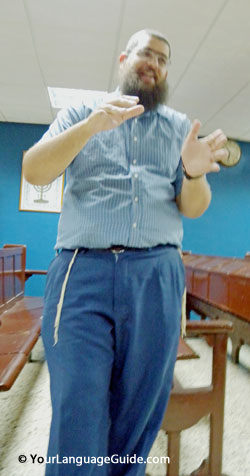 Ashenazic orthodox leader in Old Havana.
Ashenazic orthodox leader in Old Havana.Ann Marshall
- At Adat Israel, the Orthodox Ashkenazic synagogue in Old Havana, a dozen women are busy turning out handicrafts the synagogue sells to earn a bit of money. The bushy-bearded spiritual leader ushers us into a small sanctuary: room for 50 on wooden pews. He has 125 families, he tells us, and the synagogue is growing. He's also a shochet; he performs the ritual killing that assures meat will be kosher . . . and he's got stories aplenty of long days spent dispatching his duty. In Cuba, the erratic supply chain means that sometimes provisions come in flocks or herds, not individually.
 Medical supplies we took for synogogue clinics in Cuba.
Medical supplies we took for synogogue clinics in Cuba.Ann Marshall
- At Beth Shalom, Havana's largest synagogue, we tour the sanctuary, elegant with its marble and wood designs, its padded seats. Downstairs, a large community room houses social gatherings. In the youth room, a couple of teenagers are working the computers; two others are glued to the new X-Box. A widescreen TV screen commands one wall. The facility is bright, spacious, spotless. Beth Shalom's medical clinic serves the neighborhood, not only Cuban Jews, and here we leave off the first half of our donations -- new 30-gallon plastic trash bags filled with Ziploc bags of pills, medicines, and first aid supplies each of us had rounded up before we left home. The pharmacist isn't in; we stack our bagged donations in a corner and continue our tour of the synagogue. The next drop off will be in Santa Clara.
- On Friday, we attend Shabbat services at Beth Shalom. The Spanish is too rapid-fire, and the ritual too unfamiliar for me to understand, but we're treated to a charming presentation by a group of children singing a capella. It is a vibrant community; we don't have to understand the words . . . or know the tune . . . to feel it.
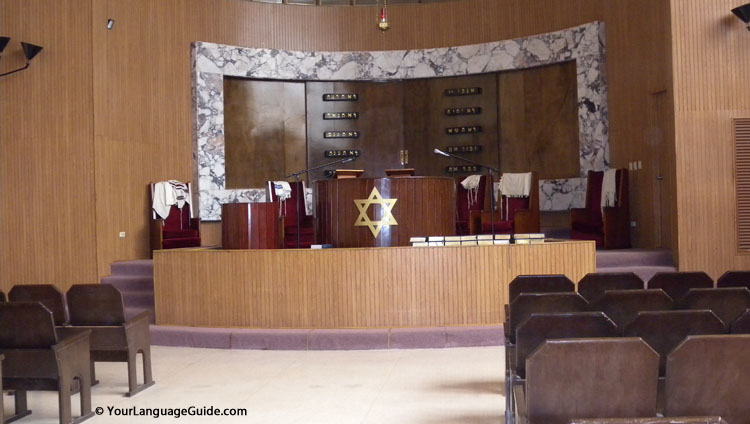 Beth Shalom’s quiet elegance, Havana, Cuba.
Beth Shalom’s quiet elegance, Havana, Cuba.Ann Marshall
Spielberg: "we must always ..."
"I am a Jew who believes in miracles. I have seen a miracle happen with rebuilding this community. Now I see that the Cuban Jewish community is the same that I come from. Size doesn't matter; commitment, passion, heart and faith are what really matter. From an early age, I was taught these words in Hebrew, Tikkun Olam, which means that we must always work to improve the world, and what better place to start than within the Jewish community. It is therefore a wonderful miracle that I'm seeing here."
-- Steven Spielberg, Havana
November 2002
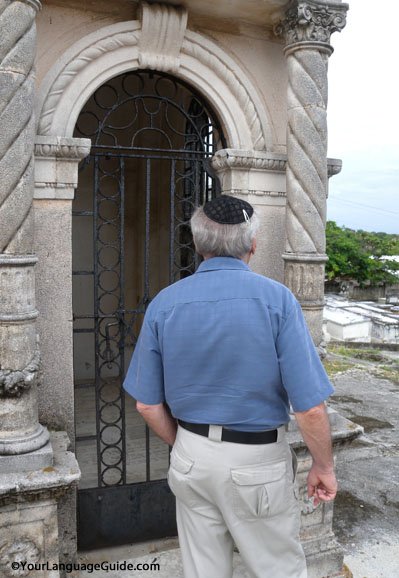 Terry explores the Jewish cemetery in Guanabacoa, Havana.
Terry explores the Jewish cemetery in Guanabacoa, Havana. Ann Marshall
Previous: Intrigue Sizzles in the Air
Next: Little-known Cuba attractions: Holocaust tributes
Terry Marshall is a language and travel enthusiast and a writer who created Walkabout Language Learning. Follow my blog as I replace decades of old memories with new observations about the culture and the place in a series of posts on our humanitarian mission to Cuba. If you have visited Cuba, I encourage you to share your experiences or leave a Facebook comment below. If you have questions about my trip, please ask. To read more of my writing, click here.
Return from Revival of Cuban Jews in Havana to Language Lore
Visit Terry Marshall's Fiction page
Or go directly to Terry's Cuba blog summaries
Stay in Touch with Language Lore ezine
Want to stay in touch? Subscribe to Language Lore, our internet language learning email newsletter. This free ezine facilitates your language learning journey. See our back issues here.
Go to your email now to confirmation your subscription. If you don't see an email within an hour (check your junk mail folder too), please contact us. We respect your privacy and never sell or rent our subscriber lists. If you want to get off this list later, one click unsubscribes you.
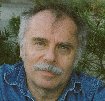
New! Comments
Have your say about what you just read! Leave me a comment in the box below.